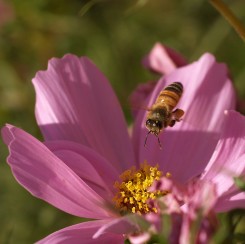Monet supposedly said, “I perhaps owe having become a painter to flowers.” Flowers are but tricks played by flowering plants to attract bees, their primary pollinators. Plants with colourful flowers that are easily seen by bees have a higher chance of distributing their pollen to other plants of the same species, thus ensuring successful reproduction.
Pollinators who are able to distinguish flowers that provide nectar have better chances of survival, since they collect more nutrients. The tenets of visual ecology theory state that the optical abilities of pollinators and the flower colours of plants will evolve to optimize the partnership between the two organisms.
Studies conducted in Israel have found that the colour discrimination ability of bees corresponds to flower colours found in nature. Furthermore, a recent study published in Proceedings of the Royal Society sampled 111 native Australian plant flowers and found similar results. Bees are able to optimally discriminate in the 400–500 nanometer-range of the light spectrum, and this aligns with commonly found flower colours.
These findings provide new information about the relationship between plants and their pollinators: pollinators such as bees apparently influence the evolution of flower colours in angiosperms (flowering plants). Since Australia had been geographically isolated for the last 34 million years, the findings are evidence of parallel evolution — the evolution of morphologically similar traits by geographically separate groups.
The fact that angiosperms on two distinct and separate land masses evolved flower colours that optimize bee discrimination suggests that bees are the driving force of flower colour evolution in angiosperms. Furthermore, bees are polylectic, meaning they can forage on multiple species of angiosperms. Thus various different plants will be susceptible to evolutionary pressures imposed by the bees.
The study also looked at the colour discrimination ability of other pollinators, such as birds and butterflies, and found that they did not match up with naturally-found flower colours as well as did the colour discrimination ability of bees. Thus bees would appear to have been the more influential dictators of angiosperm flower color evolution.
However, since flowers occur in a range of colours beyond those that bees can optimally discriminate, it is reasonable to assume that such flowers use other pollinators, such as birds or butterflies. Other studies have shown that angiosperms with flower colours that match bird vision do evolve to optimize discrimination by their pollinators.
The study also showed the fine colour discrimination that bees are capable of. It suggests that bees generalize similar colours at first, but over time their visual system tunes into specific visual cues that help them find a particular plant. The finding shows behavioural plasticity in bees, and explains why `mimic plants’ are so rare: while mimics may trick bees initially, over time the bees learn that these plants offer no reward and stop visiting them.
Evolutionary studies often ask, “What happened first?” Did the flowers mediate selective pressure on the bees or the other way around? The answer lies in fossil records; studies have shown that bee vision evolved to its present state much before angiosperm flower colour did the same. Since bees had acquired their visual capabilities before the plants established flower colour, it appears that bees influenced angiosperm flower colour evolution.
Source: Science Now



